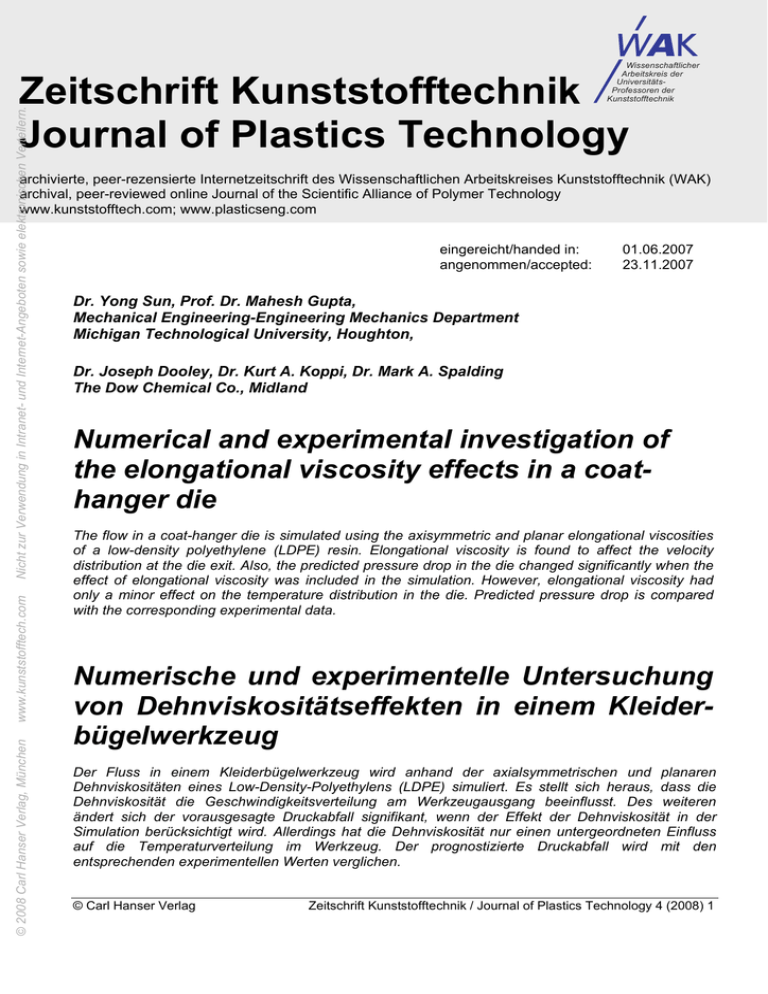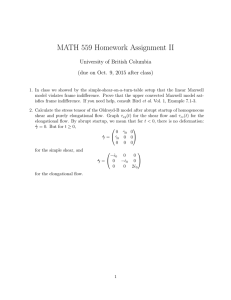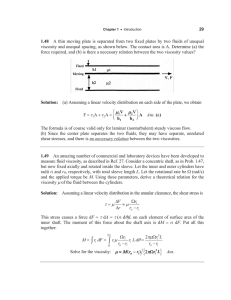Zeitschrift Kunststofftechnik Journal of Plastics Technology
advertisement

Sun et al. Wissenschaftlicher Arbeitskreis der Elongational viscosity effects in a coat-hanger dieUniversitäts- Zeitschrift Kunststofftechnik Journal of Plastics Technology Nicht zur Verwendung in Intranet- und Internet-Angeboten sowie elektronischen Verteilern. Professoren der Kunststofftechnik © 2008 Carl Hanser Verlag, München www.kunststofftech.com archivierte, peer-rezensierte Internetzeitschrift des Wissenschaftlichen Arbeitskreises Kunststofftechnik (WAK) archival, peer-reviewed online Journal of the Scientific Alliance of Polymer Technology www.kunststofftech.com; www.plasticseng.com eingereicht/handed in: angenommen/accepted: 01.06.2007 23.11.2007 Dr. Yong Sun, Prof. Dr. Mahesh Gupta, Mechanical Engineering-Engineering Mechanics Department Michigan Technological University, Houghton, Dr. Joseph Dooley, Dr. Kurt A. Koppi, Dr. Mark A. Spalding The Dow Chemical Co., Midland Numerical and experimental investigation of the elongational viscosity effects in a coathanger die The flow in a coat-hanger die is simulated using the axisymmetric and planar elongational viscosities of a low-density polyethylene (LDPE) resin. Elongational viscosity is found to affect the velocity distribution at the die exit. Also, the predicted pressure drop in the die changed significantly when the effect of elongational viscosity was included in the simulation. However, elongational viscosity had only a minor effect on the temperature distribution in the die. Predicted pressure drop is compared with the corresponding experimental data. Numerische und experimentelle Untersuchung von Dehnviskositätseffekten in einem Kleiderbügelwerkzeug Der Fluss in einem Kleiderbügelwerkzeug wird anhand der axialsymmetrischen und planaren Dehnviskositäten eines Low-Density-Polyethylens (LDPE) simuliert. Es stellt sich heraus, dass die Dehnviskosität die Geschwindigkeitsverteilung am Werkzeugausgang beeinflusst. Des weiteren ändert sich der vorausgesagte Druckabfall signifikant, wenn der Effekt der Dehnviskosität in der Simulation berücksichtigt wird. Allerdings hat die Dehnviskosität nur einen untergeordneten Einfluss auf die Temperaturverteilung im Werkzeug. Der prognostizierte Druckabfall wird mit den entsprechenden experimentellen Werten verglichen. © Carl Hanser Verlag Zeitschrift Kunststofftechnik / Journal of Plastics Technology 4 (2008) 1 © 2008 Carl Hanser Verlag, München www.kunststofftech.com Nicht zur Verwendung in Intranet- und Internet-Angeboten sowie elektronischen Verteilern. Sun et al. Elongational viscosity effects in a coat-hanger die Numerical and experimental investigation of the elongational viscosity effects in a coat-hanger die Y. Sun, M. Gupta, J. Dooley, K. A. Koppi, M. A. Spalding 1 INTRODUCTION Many different flat die configurations, namely, a T-die, a fishtail die or a coathanger die, are commonly used to extrude thin sheet or film [1]. In all of these configurations polymer is fed from the extruder to the center of the die by a circular channel. Geometry of a flat die channel is designed to transform the initial circular profile into a thin rectangular cross-section of a sheet such that a uniform velocity is obtained at the die exit. The circular channel feeds the polymer to a deep transverse channel, called the manifold, which distributes the polymer across the width of the die (Figure 1). To prevent the polymer from flowing along the die before filling the manifold, the manifold is followed by a thin slit, which is called the land. Thickness of the die channel geometry is further reduced in the die lip near the exit to obtain the required thickness of the final sheet. For the various flat die configurations listed above, the shape of the manifold is different. In the present work, a coat-hanger die was used to conduct experiments with a LDPE resin. Geometry of the die used is shown in Figure 1. The flow of the LDPE resin in the coat-hanger die was also simulated using the PELDOM software [2]. The software simulates polymeric flows taking into account strain-rate dependence of shear as well as elongational viscosity of the polymer. Similar simulations of the flow in other flat dies has been presented in our earlier publications [3, 4], and by other research groups without including the effect of elongational viscosity on the flow [5–8]. The main objective of this paper is to compare the predictions from numerical simulation of the flow with the corresponding experimental data. Journal of Plastics Technology 4 (2008) 1 1 © 2008 Carl Hanser Verlag, München www.kunststofftech.com Nicht zur Verwendung in Intranet- und Internet-Angeboten sowie elektronischen Verteilern. Sun et al. Elongational viscosity effects in a coat-hanger die Manifold 1 4 3 Land 2 Lip Figure 1: Geometry of the coat-hanger die and locations of pressure transducers 2 MATERIAL PROPERTIES The material used for these studies was a LDPE resin with a melt index (MI) of 0.22 dg/min (190oC, 2.16 kg) and a solid density of 0.921 g/cm3. The resin was manufactured by The Dow Chemical Company. To capture the strain-rate dependence of shear ( η s ) and elongational viscosities ( η e ) of the LDPE resin, the Carreau model [9] and Sarkar-Gupta model [10], respectively, were used in this work: Journal of Plastics Technology 4 (2008) 1 2 © 2008 Carl Hanser Verlag, München Elongational viscosity effects in a coat-hanger die η s = η 0 (1 + (λe II ) 2 ) n −1 2 m −1 ⎡ ⎧⎪ ⎫⎪⎤ 1 2 ηe = η0 ⎢Tr + δ ⎨1 − ⎬⎥ (1 + (λ2eII ) ) 2 2 ⎢ 1 + (λ1eII ) ⎪⎭⎥⎦ ⎪⎩ ⎣ (1) (2) where, eII , the second invariant of the strain-rate tensor is the same as the shear rate, γ& , for a shear flow, and 3ε& and 2ε& , respectively, for axisymmetric and planar elongational flows, with ε& being the elongation rate. In equations (1) and (2), η0 , δ , λ , λ1 , λ2 , n and m are material parameters, and Tr , the Trouton ratio at low strain rates, is 3 for an axisymmetric flow and 4 for a planar flow. An Arrhenius-type model [9] is used here for temperature dependence of the zeroshear viscosity (η0 ), in Eqns (1) and (2): η0 = A exp(Ta / T ) (3) where T is the temperature of the polymer, and A and Ta are material parameters. For the LDPE resin, the values of various viscosity parameters for Carreau model and the Sarkar-Gupta model are given in Table 1 [11]. Based upon these parameter values, the shear and elongational viscosities of the resin are shown in Figure 2. 0.25 W/m K 740 kg/m3 Cp 2300 J/kg K A 469.08 Pa⋅s Ta Shear 2721.7 K viscosity λ 0.6509 n 0.401 δ 37.3 λ1 11.795 s Planar λ2 0.4571 s Elongational m 0.45 viscosity δ 0.0 Axisymmetric λ 2 0.02242 s m 0.349 Thermal and mechanical properties www.kunststofftech.com Nicht zur Verwendung in Intranet- und Internet-Angeboten sowie elektronischen Verteilern. Sun et al. Table 1: K ρ Material properties of the LDPE resin used in this study [3, 11] Journal of Plastics Technology 4 (2008) 1 3 © 2008 Carl Hanser Verlag, München www.kunststofftech.com Elongational viscosity effects in a coat-hanger die The thermal conductivity ( K ), melt density ( ρ ) and heat capacity ( C p ) of the polymer were assumed to be constant for the range of temperature in the flat dies. Since the actual values of K , ρ and C p for the resin used in experiments were not known, typical values of K , ρ and C p for a LDPE resin were used for the flow simulation. These values of K , ρ and C p are also given in Table 1 [3, 11]. ηep Cogswell 10 7 10 6 ηs, ηea, ηep (Pa.s) Nicht zur Verwendung in Intranet- und Internet-Angeboten sowie elektronischen Verteilern. Sun et al. 10 10 η ea Binding ηep Binding ηep ηea 5 ηs carreau (215oC) ηea optimization (215oC) o ηep optimization (215 C) ηea Binding (215oC) o ηep Binding (215 C) o ηs carreau(230 C) ηea optimization (230oC) o ηep optimization (230 C) ηea Binding (230oC) ηep Binding (230oC) o ηs experimental (215 C) ηs experimental (230oC) ηea Cogswell (215oC) o ηea Cogswell (230 C) ηep Cogswell (215oC) ηep Cogswell (230oC) 4 10 3 10 2 10-5 10-4 10-3 . . 10-2 10-1 ηea Cogswell ηs 100 . 101 102 103 eII=γ, √3ε(axisymmetric), 2ε(planar)(s-1) Figure 2: Variation of shear ( η s ) and elongational ( η ep (planar), η ea (axisymmetric) ) viscosities of LDPE with the second invariant of strain-rate tensor ( e II ). Journal of Plastics Technology 4 (2008) 1 4 © 2008 Carl Hanser Verlag, München www.kunststofftech.com Nicht zur Verwendung in Intranet- und Internet-Angeboten sowie elektronischen Verteilern. Sun et al. 3 Elongational viscosity effects in a coat-hanger die DIE GEOMETRY Geometry of the coat-hanger die used in this work [12], is shown in Figure 1. The polymer is fed vertically to the top of the die manifold through a cylindrical channel. The cylindrical channel has a constant diameter of 1.27cm. The upper side of the die is completely flat. Various features such as the manifold, land and lip shown in Figure 1 are machined in the lower die plate. Near the entrance in the middle of the die, the manifold depth and width are 0.95 and 1.27 cm, respectively. The manifold depth as well as width decrease towards the sides, to 0.254 cm at the ends. From the die manifold, the polymer enters into a thin land. The land has a uniform depth of 0.254 cm. The larger depth of the die manifold helps to distribute the polymer across the width of the die before it enters in the thin triangular land. The length of the land along the flow direction is 5.451 cm at the two ends and 10.16 cm in the middle. Near the exit, in the lip region of the die, the depth of the die channel decreases further to 0.1524 cm. Along the flow direction, the length of the lip region as well as that of the converging transition region between the land and lip is 0.4775 and 0.4877 cm respectively. As shown in Figure 1, the coat-hanger die has four pressure transducers, which are located in the land region. Transducers 1 and 2 are located along the center line of the die at a distance of 8.255 and 3.81cm, respectively, from the die exit. Transducers 2, 3 and 4 are located at the same axial location, and 5.08 cm apart from each other in the lateral direction. The four transducers are connected to a data acquisition system, which records the pressure data on a computer. 4 RESULTS AND DISCUSSION The finite element mesh used to simulate the flow in the coat-hanger die is shown in Figure 3. The finite element mesh has 252,759 tetrahedral elements. A constant velocity corresponding to the flow rate of 2.72 × 10 −6 m3/s (7.25 kg/h) was enforced at the entrance of the circular channel. A no-slip condition was specified at the die walls, and no-traction (stress-free) condition was employed at the exit. The polymer entered the die at 473 oK, which is the same as the die wall temperature. Figure 4 compares the velocity distributions in the midplane of the die lip predicted by the generalized Newtonian formulation (Figure 4 a) and that after including the effect of elongational viscosity in the simulation (Figure 4 b). Corresponding velocity distributions in the plane of symmetry passing through the axis of the circular inlet channel are shown in Figure 5. Journal of Plastics Technology 4 (2008) 1 5 Elongational viscosity effects in a coat-hanger die Figure 3: Finite element mesh in the coat-hanger die © 2008 Carl Hanser Verlag, München www.kunststofftech.com Nicht zur Verwendung in Intranet- und Internet-Angeboten sowie elektronischen Verteilern. Sun et al. (a) (b) (m/s) Figure 4: Velocity distribution in the mid-plane of the coat-hanger die. (a) Carreau model, (b) Sarkar-Gupta model for elongational viscosity Journal of Plastics Technology 4 (2008) 1 6 © 2008 Carl Hanser Verlag, München www.kunststofftech.com Nicht zur Verwendung in Intranet- und Internet-Angeboten sowie elektronischen Verteilern. Sun et al. Elongational viscosity effects in a coat-hanger die With the generalized Newtonian formulation, the constant velocity distribution at the entrance of the circular channel quickly changes to the fully developed velocity profile. In order to achieve the fully developed profile, the fluid near the middle of the channel needs to accelerate, whereas the fluid near the channel walls decelerates. (a) (b) (m/s) Figure 5: Velocity distribution in the plane of symmetry in the thickness direction of the coat-hanger die. (a) Carreau model, (b) Sarkar-Gupta model for elongational viscosity. The elongational flow due to this redistribution of the velocity field is slowed down when the effect of higher elongational viscosity is included in the simulation. Therefore, when the effect of the higher elongational viscosity is included in the simulation Figure 5b, the polymer is not able to achieve a fully developed velocity profile before it reaches the die entrance. Because of the larger depth of the manifold, instead of entering the land region of the die, polymer has a tendency to first flow through the manifold. However, since the depth and width of the manifold decrease towards the two ends, the flow in the manifold is somewhat elongational in nature. Due to this elongational nature of the flow in the manifold, as the effect of elongational viscosity is Journal of Plastics Technology 4 (2008) 1 7 Elongational viscosity effects in a coat-hanger die included in the simulation, the polymer has a slightly smaller tendency to flow through the manifold and higher tendency to enter the triangular land region. Therefore, near the entrance, the velocity is slightly higher in the triangular land region when the effect of elongational viscosity is included in the simulation. As shown in Figure 6, this higher velocity near the middle of the triangular land region leads to higher unbalancing in the velocity distribution at the die exit when the effect of elongational viscosity is included in the simulation. From Figure 6, which shows the exit velocity distribution at the mid-plane, it appears as if the flow rate is lower when the effect of elongational viscosity is included in the simulation. However, the lower mid-plane velocity in the case with elongational viscosity effects is because of a difference in the gap-wise velocity distribution in the two simulations. It was confirmed that the flow rate at exit is the same in both the simulations. 0.011 0.01 0.009 0.008 Exit velocity (m/s) www.kunststofftech.com Nicht zur Verwendung in Intranet- und Internet-Angeboten sowie elektronischen Verteilern. Sun et al. 0.007 0.006 Without elongational viscosity With elongational viscosity 0.005 0.004 0.003 0.002 © 2008 Carl Hanser Verlag, München 0.001 0 -0.1 0 0.1 Die width (m) Figure 6: Velocity distribution at the die Journal of Plastics Technology 4 (2008) 1 8 Elongational viscosity effects in a coat-hanger die Figures 7 and 8 show the effect of elongational viscosity on the pressure distributions in the coat-hanger die. Figure 7 shows the pressure distribution in the plane passing through the middle of the die lip, whereas the pressure in the plane of symmetry through the middle of the inlet channel is shown in Figure 8. Total pressure drop in the coat-hanger die and circular inlet channel predicted by the generalized Newtonian formulation is 4.1 MPa. The inlet pressure increases to 4.7 MPa when the effect of elongational viscosity is included in the simulation. A large fraction of this increase in total pressure drop due to high elongational viscosity is in the region where the circular channel is connected to the die inlet. In this region, where the polymer makes a 90o turn, the flow is highly elongational in nature. Additional increase in pressure drop due to high elongational viscosity of polymer occurs in the converging transition region between die land and lip, and near the abrupt step between the manifold and land. For the pressure transducer locations shown in Figure 1, the experimental data and the corresponding numerical predictions are given in Table 2. In general, as expected, the pressure at the four transducer locations predicted after including the effect of elongational viscosity in the simulation is higher than the pressure predicted by generalized Newtonian formulation. For all four transducer locations the predicted pressure is in excellent agreement with the experimental data. Numerical simulation predicted the highest pressure along the center line (location 1) which decreased as the distance from the center line is increased. However, the decrease in the pressure away from the centerline is within the accuracy of the experimental measurement ( ± 0.1 MPa), and could not be captured in the experimental data. © 2008 Carl Hanser Verlag, München www.kunststofftech.com Nicht zur Verwendung in Intranet- und Internet-Angeboten sowie elektronischen Verteilern. Sun et al. Journal of Plastics Technology 4 (2008) 1 9 © 2008 Carl Hanser Verlag, München www.kunststofftech.com Nicht zur Verwendung in Intranet- und Internet-Angeboten sowie elektronischen Verteilern. Sun et al. Elongational viscosity effects in a coat-hanger die (a) (b) (Pa) Figure 7: Pressure distribution in the mid-plane of the coat-hanger die (a) Carreau model, (b) Sarkar-Gupta model for elongational viscosity (a) (b) (Pa) Figure 8: Pressure distribution in the plane of symmetry in the thickness direction of the coat-hanger die. (a) Carreau model, (b) Sarkar-Gupta model for elongational viscosity. Journal of Plastics Technology 4 (2008) 1 10 © 2008 Carl Hanser Verlag, München www.kunststofftech.com Nicht zur Verwendung in Intranet- und Internet-Angeboten sowie elektronischen Verteilern. Sun et al. Elongational viscosity effects in a coat-hanger die Figure 9 shows the effect of elongational viscosity on the temperature distribution in the plane passing through the middle of the die lip. Starting with 473 K, the temperature increases slightly up to 473.5 K due to viscous dissipation. When the effect of elongational viscosity was included in the simulation, the predicted temperature near the manifold increased. But the increase in temperature due to elongational viscosity effects is quite small. (a) (b) (K) Figure 9: Temperature distribution in the mid-plane of the coat-hanger die. (a) Carreau model, (b) Sarkar-Gupta model for elongational viscosity. Journal of Plastics Technology 4 (2008) 1 11 © 2008 Carl Hanser Verlag, München www.kunststofftech.com Nicht zur Verwendung in Intranet- und Internet-Angeboten sowie elektronischen Verteilern. Sun et al. Table 2: 5 Elongational viscosity effects in a coat-hanger die Pressure Transducer Number Experimental data ( ± 0.1 MPa) 1 2 3 4 2.8 1.5 1.6 1.5 Numerical prediction (MPa) With Without elongational elongational viscosity viscosity 2.84 2.67 1.54 1.39 1.51 1.37 1.44 1.33 Experimental data and numerical prediction of pressure in the coathanger die. CONCLUSIONS The axisymmetric and planar elongational viscosities of a LDPE resin were used in the present work to simulate the flow in a coat-hanger die. For the flow of LDPE resin in the coat-hanger die used, the elongational viscosity is found to have a significant effect on the velocity at the die exit, as well as on the predicted pressure drop in the die. Predicted pressure distribution in the die is found to be in good agreement with the corresponding experimental data. 6 ACKNOWLEDGEMENT This work was supported by the National Science Foundation Grant DMI0200091. 7 REFERENCES [1] Michaeli, W. Extrusion Dies for Plastics and Rubber Hanser Publishers, New York, 1992 [2] PELDOM software Plastic Flow LLC, 1206 Birch Street, Houghton, MI 49931 Journal of Plastics Technology 4 (2008) 1 12 © 2008 Carl Hanser Verlag, München www.kunststofftech.com Nicht zur Verwendung in Intranet- und Internet-Angeboten sowie elektronischen Verteilern. Sun et al. Elongational viscosity effects in a coat-hanger die [3] Sun, Y.; Gupta, M. Int. Polym. Proc. Journal, 18, 356 – 361, 2003 [4] Sun, Y.; Gupta, M. SPE ANTEC Tech. Papers, 50, 3307 – 3311, 2004 [5] Gupta, M.; Jaluria, Y.; Sernas, V.; Esseghir, M.; Kwon, T.H. Poly. Eng. Sci., 33, 393, 1993 [6] Shankar, R.; Ramanathan, R. SPE ANTEC Tech. Papers, 41, 65, 1995 [7] Gifford, W.A. SPE ANTEC Tech. Papers, 44, 290, 1998 [8] Gifford, W.A. Poly. Eng. Sci., 41, 1886, 2001 [9] Bird, R.B.; Armstrong, R.C.; Hassager, O. Dynamics of Polymeric Liquids, Vol. 1 and 2, Wiley, New York, 1987 [10] Sarkar, D.; Gupta, M. J. Reinf. Plast. Comp., 20, 1473, 2001 [11] Beaupre, P.; Gupta, M. Int. Polym. Proc. Journal, 17, 370, 2002 [12] Dooley, J. SPE ANTEC Tech. Papers, 36, 168, 1990 Key words: Coat-hanger die, Elongational viscosity, Low-density polyethylene (LDPE), Finite element method Stichworte: Kleiderbügelwerkzeug, Dehnviskosität, Low-Density-Polyethylen (LDPE), FiniteElemente-Methode Journal of Plastics Technology 4 (2008) 1 13 © 2008 Carl Hanser Verlag, München www.kunststofftech.com Nicht zur Verwendung in Intranet- und Internet-Angeboten sowie elektronischen Verteilern. Sun et al. Elongational viscosity effects in a coat-hanger die Autor/author: Dr. Yong Sun Prof. Dr. Mahesh Gupta Mechanical EngineeringEngineering Mechanics Department Michigan Technological University, Houghton, MI 49931 E-Mail-Adresse: mahesh@mtu.edu Webseite: www.mtu.edu Tel.: +1 (0)906/487-3566 Fax: +1 (0)906/487-2822 Dr. Joseph Doole Dr. Kurt A. Koppi Dr. Mark A. Spalding The Dow Chemical Co., Midland, MI 48667 Herausgeber/Editor: Europa/Europe Prof. Dr.-Ing. Dr. h.c. Gottfried W. Ehrenstein, verantwortlich Lehrstuhl für Kunststofftechnik Universität Erlangen-Nürnberg Am Weichselgarten 9 91058 Erlangen Deutschland Phone: +49/(0)9131/85 - 29703 Fax.: +49/(0)9131/85 - 29709 E-Mail-Adresse: ehrenstein@lkt.uni-erlangen.de Verlag/Publisher: Carl-Hanser-Verlag Jürgen Harth Ltg. Online-Services & E-Commerce, Fachbuchanzeigen und Elektronische Lizenzen Kolbergerstrasse 22 81679 Muenchen Tel.: 089/99 830 - 300 Fax: 089/99 830 - 156 E-mail-Adresse: harth@hanser.de Journal of Plastics Technology 4 (2008) 1 Amerika/The Americas Prof. Prof. h.c Dr. Tim A. Osswald, responsible Polymer Engineering Center, Director University of Wisconsin-Madison 1513 University Avenue Madison, WI 53706 USA Phone: +1/608 263 9538 Fax.: +1/608 265 2316 E-Mail-Adresse: osswald@engr.wisc.edu Beirat/Editorial Board: Professoren des Wissenschaftlichen Arbeitskreises Kunststofftechnik/ Professors of the Scientific Alliance of Polymer Technology 14




